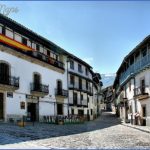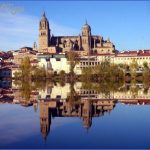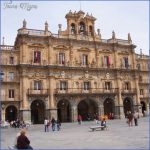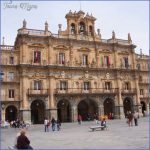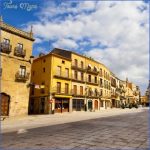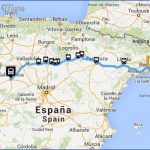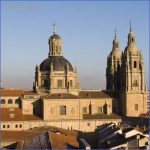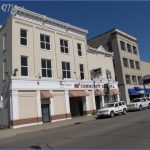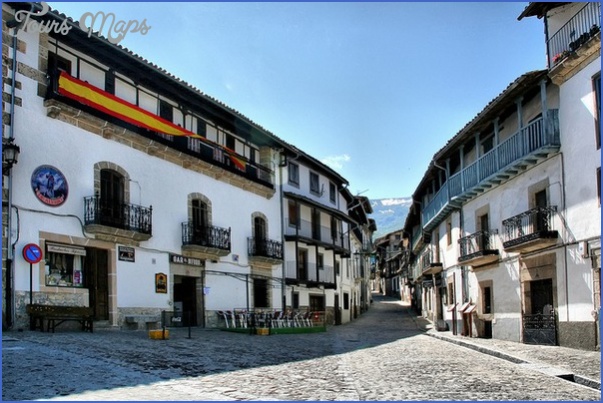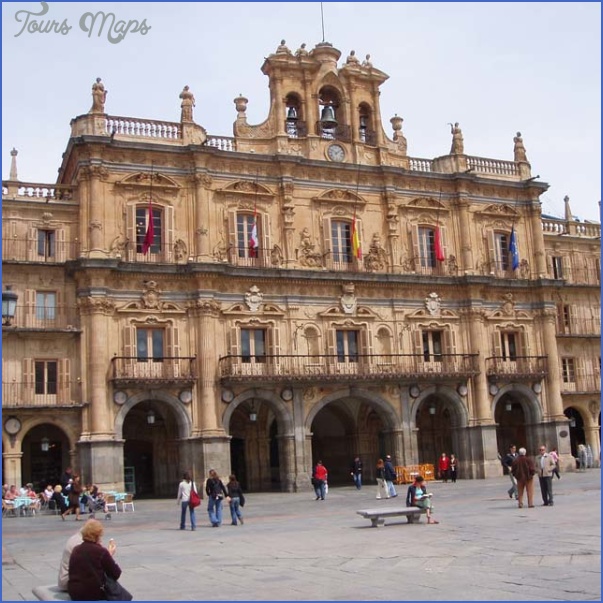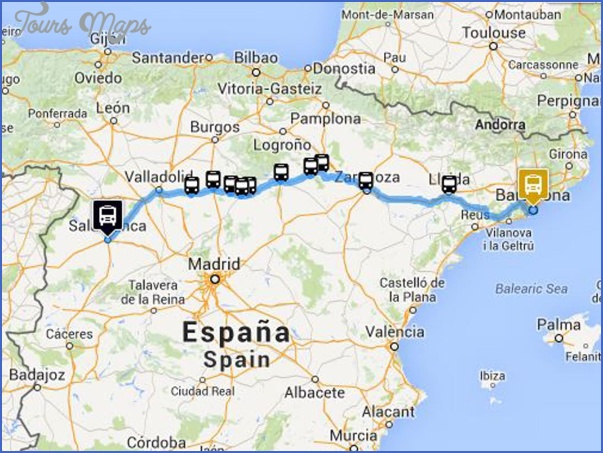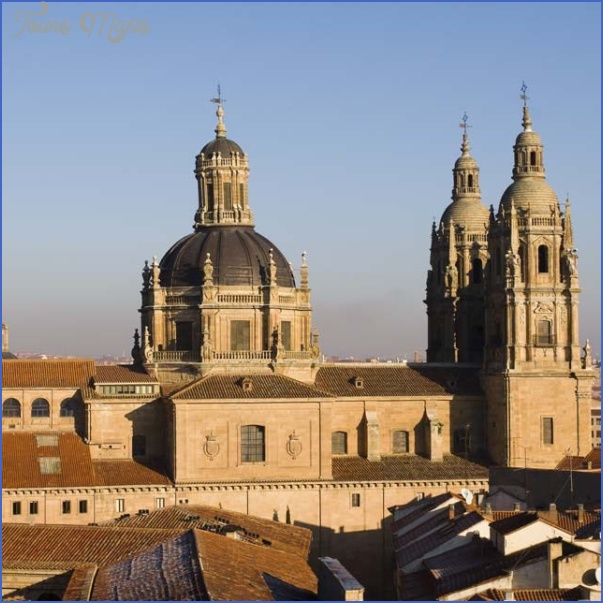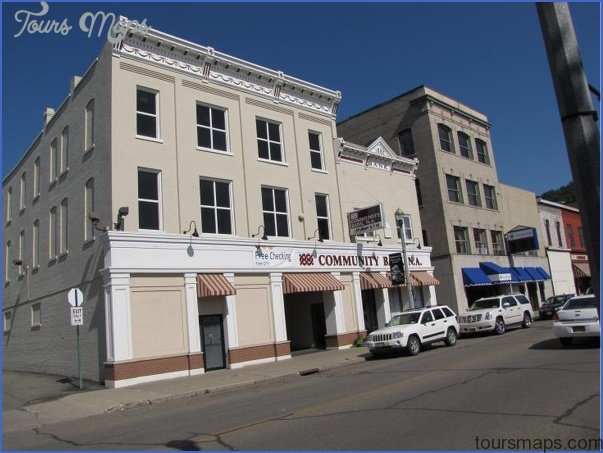SIGHTS
PLAZA MAYOR. Salamanca’s Plaza Mayor, designed by Alberto Churriguera, has been called one of the most beautiful squares in Spain. Hundreds of tables ring the center, where street performers and musicians entertain and couples stroll hand in hand. Shaped from the majestic sandstone that pervades Salamanca’s architecture, the plaza appears golden under the afternoon sun or when the lights come up to collective gasps of admiration at night. Built between 1729 and 1755, the plaza contains 88 towering arches, the Ayuntamiento, and three pavilions dedicated to historical figures. The Pabellon Real, to the right of the Ayuntamiento, honors the Spanish monarchy, including the controversial 20th-century dictator Franco; the Pabellon del Sur, in front of the Ayuntamiento, is dedicated to famous Spanish conquistadors; and the Pabellon del Oeste, to the left of the Ayuntamiento, pays homage to important salmantinos like San Juan de Sahagun, Santa Teresa, Unamuno, and Cervantes, who studied at the city’s university. Before the pavilions were built, the square served as the town bullring; today, more wide-eyed tourist groups than bulls flood the plaza.
THE UNIVERSITY. The great university, established in 1218, is the focal point of Salamanca. Best entered from C. Libreros, the university’s entryway is one of the greatest examples of Spanish Plateresque, a style named for the delicate filigree work of plateros (silversmiths). The central medallion represents Ferdinand and Isabella, while the one up higher is generally thought to represent the Pope. Hidden in the sculptural work lies a tiny frog; according to legend, those who can spot the frog without assistance will be blessed with good luck and even marriage.
The old lecture halls inside are open to the public; entering the cool stone foyer feels like stepping into another era. The Paraninfo (auditorium) contains Baroque tapestries and a portrait of Carlos IV attributed to Goya. Along with red curtains, red velvet chairs, and a red altar, the 18th-century chapel contains the burial sight of Fray Luis de Leon. Located on the second floor atop a magnificent Plateresque staircase is the spectacular Antigua Bibiioteca, one of Europe’s oldest libraries. The staircase is generally thought to represent the ascent of the young student through playfulness, amor, and adventure to the true love of knowledge.
Facing the university entrance is the Patio de las Escueias, which contains a statue of Fray Luis, a university professor and one of the most respected literati of the Golden Age. A Hebrew scholar and classical Spanish stylist, Fray
Luis was arrested by the Inquisition for translating Solomon’s Song of Songs into Castilian and for preferring the Hebrew version of the Bible to the Latin one. After five years of imprisonment, he returned to the university and began his first lecture, Como deciamos ayer… (As we were saying yesterday.. Don’t miss the University Museum, which is through the hallway on the left corner of the patio. The reconstructed Cielo de Salamanca, the library’s famous 15th-century fresco of the zodiac painted on the ceiling by the celebrated Fernando Gallego, is preserved here in all its splendor. Take a peek at the intricate strongbox with its many locks. (From Plaza Mayor follow R. Mayor, veer right onto R. Antigua, then left onto C. Libreros; the university is on the left. University it 923 29 44 00. Museums923 29 12 25. Open M-F9:30am-l:30pm and4-7:30pm, Sa 9:30am-l:30pm and 4-7pm, Su 10am-l:30pm. University and museum ‚2.40, students and seniors ‚1.20.)
CATEDRAL NUEVA. It took 220 years to build this striking Gothic Spanish building (1513-1733). Its architects combined the original late Gothic style with touches from later periods, most notably to its Baroque tower, one of the tallest in Spain. Inside, the cathedral is separated into several small chapels that are dedicated to various saints or important locals. The chapels surround a center chapel and an enormous organ, whose pipes rise up toward the high ceiling. The cathedral was recently renovated, and the architects left their marks: Look for the astronaut and a dragon eating an ice cream cone on the left side of the main door. (From Plaza Mayor, walk down R. Mayor into PI. Anaya; the Catedrai Nueva will be in front of you. Open Apr.-Sept. daily 9am-2pm and 4-8pm; Oct.-Mar. 9am-lpm and 4-6pm. Free.)
CATEDRAL VIEJA. The smaller Catedrai Vieja (1140) was built in the Romanesque style. The cupola, assembled from intricately carved miniature pieces, is one of the most detailed in Spain. Above the high altar, apocalyptic angels separate the sinners from the saved. The oldest original part of the cathedral is the Capilla de San Martin, with brilliant frescoes dating from 1242. Look for the image of the Virgen de la Vega, Salamanca’s patron saint. The museum features a paneled ceiling by Fernando Gallego and houses the Mudejar Salinas organ, one of the oldest in Europe. Be sure to check out the famed Patio Chico, behind the cathedral, where students congregate to chat and play music. It offers splendid views of both cathedrals. (Enter through the Catedrai Nueva. Museum s923 21 74 76. Cathedral open Apr.-Sept. daily 10am-l:30pm and 4-7:30pm. Cathedral, cloister, and museum ‚3, students ‚2.25, children ‚1.50.)
CASA LIS MUSEO ART NOUVEAU Y ART DECO. Salamancan industrialist Miguel de Lis collaborated with modernist architect Joaquin Vargas to design the building, which now showcases Lis’s eclectic art collection. Exhibits range from the elegant (fans signed by such noteworthies as Salvador Dali) to the odd (porcelain dolls with two faces), to the racy (small sculptures of animals and people in compromising positions). (C. Gibraltar 14, behind the cathedrals. 923 12 14 25. Open Apr.-Oct. 15 Tu-F llam-2pm and 5-9pm, Sa-Su llam-9pm; Oct. 16-Mar. Tu-F llam-2pm and 4-7pm, Sa-Su llam-8pm. ‚2.10, students ‚1.50. Children and Tu mornings free.)
CASA DE LAS CONCHAS. From Plaza Mayor, follow R. Mayor until you reach a plaza with a water fountain. Take a right, and then take a gander at the 15th-century Casa de las Conchas (House of Shells), with over 300 large scallop halves, one of Salamanca’s most famous landmarks. Pilgrims who journeyed to Santiago de Compostela wore shells to commemorate their visit to the tomb of St. James. According to legend, the owner of the casa created this monument either to honor the renowned pilgrimage or to honor his wife, whose family shield was decorated with scallops. Legend has it that when the Jesuits leveled every house in the area to build the college, the Casa de las Conchas was the only one that was not bought, despite the Jesuits’s offer of one gold coin for every sandstone shell. The building now serves as a public library and houses the provincial tourist office. (C. Companla 39. Library s 923 26 93 17. Open M-F 9am-9pm, Sa-Su 9am-2pm and 47pm. Free.)
PUENTE ROMANO. This 2000-year-old Roman bridge, spanning the scenic Rio Tonnes at the edge of the city, was once part of an ancient Roman road called the Camino de la Plata (Silver Way). The Camino ran from Merida in Extremadura to Astorga and was heavily traveled during the Roman occupation of Spain. In medieval times, the Camino was the route most Andalucian and Castilian Christians took to complete their pilgrimage to Santiago de Compostela. The bridge is guarded at its end by a headless granite bull called the Toro Iberico. Though it dates back to pre-Roman times, the bull gained fame in the 16th century when it appeared in Lazarillo de Tormes, the prototype of the picaresque novel and a predecessor of Don Quijote; in one episode the novel’s hero gets his head slammed into the bull’s stone ear after he cheats his employer.
Travel to Salamanca Photo Gallery
Maybe You Like Them Too
- Explore Góra Kalwaria, Poland with this detailed map
- Explore Gumdag, Turkmenistan with this detailed map
- Explore Telfes im Stubai, Austria with this detailed map
- Explore Langenselbold, Germany with this detailed map
- Explore Krotoszyn, Poland with this detailed map

